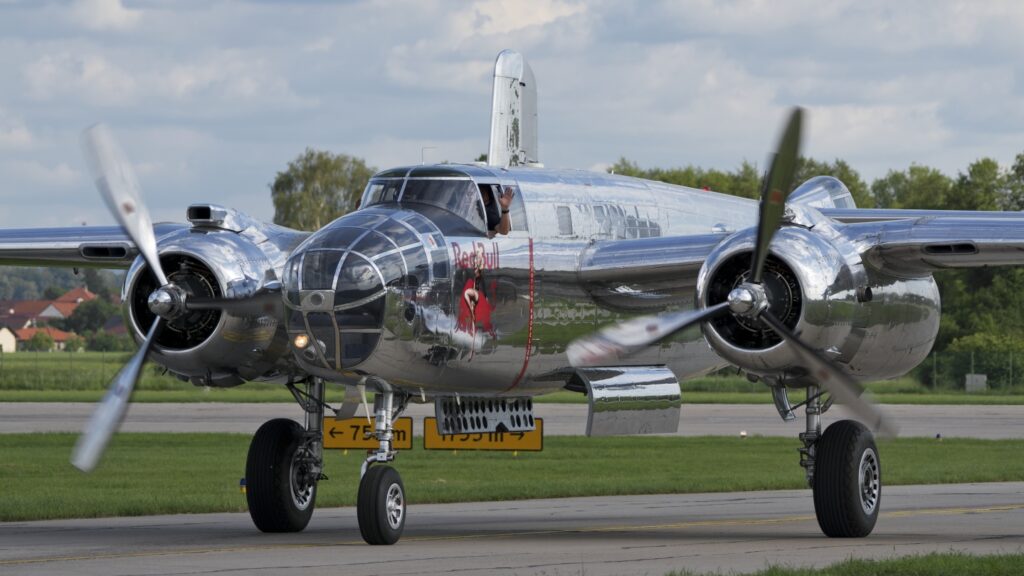 On 19th August 1940, prototype of a twin-engine medium bomber, later known as B-25 Mitchell, performed its maiden flight at Mines Field, Los Angeles.
On 19th August 1940, prototype of a twin-engine medium bomber, later known as B-25 Mitchell, performed its maiden flight at Mines Field, Los Angeles.
In the late 1930s, the United States Army Air Corps (USAAC) was looking for a future attack and bomber aircraft. The first army requirements regarding such aeroplanes were stated in March 1938, within the circular 38-385, and almost immediately responded by all main American aviation manufacturers: Bell, Boeing-Stearman, Douglas, Martin and North American. The latter proposed an aircraft designated NA-40, being a development of XB-21 (NA-39) – a successful design from 1936 that was already approved by the military authorities for serial production but eventually cancelled.
The NA-40 was a twin-engine bomber, powered by Pratt & Whitney R-1830 radial engines and manned by a crew of five. The prototype took-off for its maiden flight in January of 1939 but, being both underpowered and unstable during the flight, the aircraft failed in the competition. Quick upgrade done by the North American company to another prototype, known as NA-40B and powered by two Wright R-2600 engines, have not save that design. Eventually, the USAAC had chosen the Douglas DB-7 as the future attack bomber, the aircraft later known as A-20 Havoc.
In March of 1938, next USAAC circular was issued, announcing requirements for a medium bomber. The North American Aviation company entered that competition with their concept designated NA-62, being just another re-development of the abovementioned NA-40. This time, due to increasing tensions in the world and awareness of upcoming war, the contest was quick, and successful for the North American company. In September of 1939, the NA-62 and another design proposed by Martin (later known as B-26 Marauder) were both approved ´off the drawing board´, without evaluating any prototypes.
The first prototype of the NA-62 (s/n 40-2165) took-off for its maiden flight on 19th August 1940, at Mines Filed in Los Angeles (nowadays Los Angeles International Airport). The aircraft was flown by test crew of Vance Breese as the first pilot and Roy Ferren as co-pilot.
Shortly after, the new aeroplane was approved for serial manufacture and officially named B-25 Mitchell, in honour of Major General William Mitchell, the pioneer of US military aviation. According to the Boeing company (an official successor of North American Aviation) and information from the corporate web site, it required 8,500 original drawings and 195,000 engineering man-hours to produce the first aircraft of that type.

Nevertheless, it turned out that the aircraft had significant problems with stability and re-design of its wings was necessary. Due to pressure from military authorities, the serial production of the B-25 was launched before that change was implemented. Therefore, the modernization started from the tenth aircraft in the series – the first nine examples were built with original, constant dihedral angle wings.
The initial production series was equipped with two R-2600-9 engines, each generating 1,350 hp. The aircraft could carry up to 1,600 kg of bombs and had an armament of four machine guns. In 1941, the first variant of the aeroplane, designated B-25A, entered active service. Within a year, it was succeeded by already modernized version, known as B-25B.
In April of 1942, the North American B-25 Mitchell went down in history of aviation. A formation of sixteen B-25B aircraft, led by Lt. Col. Jimmy Doolittle, took-off from USS Hornet aircraft carrier and performed successful air raid against mainland Japan. That brave operation, completed just four months after the Pearl Harbor raid, boosted the morale of the Americans and gained worldwide recognition for the aircraft.
In the following years, the B-25 became one of the most-popular Allied medium bombers. Nearly 10,000 examples were built, and the aircraft could be spotted at every theatre of the World War II. Apart from the USAF, the B-25 was also operated with the Royal Air Force, the Royal Australian Air Force, Polish, French and Dutch air forces in exile, the Soviet Air Force, the Brazilian Air Force and the China Air Force.
There were several variants and modifications of the original aircraft developed. They included photo reconnaissance version, weather reconnaissance aeroplane, training aeroplanes and a variety of anti-submarine aircraft for the Allied navies.
After the World War II, the Mitchell continued its military service in even more air forces and navies of the world. The B-25 were flown in countries such as Argentina, Cuba, Canada, Spain, Uruguay or Venezuela. Two aircraft were also used by the Biafran Air Force during the secession period.
Nowadays, approximately one hundred of the B-25 Mitchells are still maintained in airworthy conditions. The aircraft are a frequent participant of air shows all over the world, always attracting attention of aviation enthusiasts and general public.






